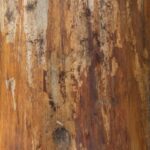Introduction
Repainting gloss woodwork gives a number of great benefits to your home improvement project, including improved durability and a beautiful, vibrant finish. To get the best possible results and make sure that your project is as satisfying and successful as it can be, you should take some time to properly prepare.
Firstly, it’s important to set yourself up for success by having the right mindset. To do this, it’s a good idea to make sure that you are patient, organized and not scared of getting your hands dirty! Once you’ve got yourself in the right frame of mind, it’s time to gather the materials you’ll need. The exact items required will depend on the type of woodwork being worked on – but some basics include primer, glossy paint, sandpaper or paint thinner (for preparing surfaces), paintbrushes, rags and drop cloths (to protect other surfaces).
Pre-treatment
Before repainting gloss woodwork, it’s important to follow a few steps in order to ensure the project is successful and the results are long-lasting.
First, you need to test the sheen of the gloss of your existing woodwork. It could be semi-gloss or high gloss, so it’s important to know exactly what you’re dealing with before beginning any painting work. Once you have determined the sheen, you should sand down the surface of the woodwork with a medium-grit sandpaper in order to remove any impurities and create a smooth texture for painting purposes. Afterwards, use a damp rag or cloth to collect any dust from the woodwork and then allow it to dry completely.
Next, fill any dents or chips that you find on the woodwork using wood filler. Then take a tack cloth and carefully clean off all paint residue that might be present on surfaces. Once this is done, apply an even coating of primer over all areas of your wooden furniture/woodwork that are going to be painted as well as adjacent surfaces such as walls or trim. The primer sealer should have been chosen based on whether your existing paint job was oil or latex; make sure to follow instructions carefully when applying it as some primers require additional coats.
Applying Paint
First, if your woodwork already has a glossy finish, be sure to scuff it up with a sandpaper before repainting. The surface must be as free of any gloss or sheen as possible for the new paint layer to adhere correctly. Once prepped, consider the type of brush you’ll use to paint your gloss woodwork. Depending on the type and brand of paint used, a natural-bristle brush may provide satisfactory results. For a professional finish, however, it is best to invest in an advantageous synthetic-bristle flat or angular brush intended for painting semi-gloss trim. This type of brush distributes its metal blend fibers evenly for covering flat and hard edges with ease.
When selecting a paint color and sheen, note that higher sheens offer more reflectivity and greater durability advantages than lower sheens such as flat or eggshell finishes. However, too much gloss in excess of what’s standard driving expectance or aesthetics can diminish quality and convey offbeat visual effects. Semigloss paint usually provides an excellent balance of affordability, boldness and functionality when applied on wooden surfaces but double check that your chosen color works alongside other fixtures in the room before you commit!
Painting Techniques
Rolling and brushing on the paint: When repainting gloss woodwork, you will need to use a roller brush. Start by rolling the brush onto the surface in a series of ‘W’ motions. Once you have achieved an evenly applied coat of paint, you can switch to using a brush for detailed areas such as corners and mouldings, ensuring that the quantity and direction of your brush strokes blend with those produced by the roller earlier.
Adding textures: To add accents or texture to your newly painted surface you can use a textured sponge that you can either roll or dab on in specific places. This is useful for disguising any unavoidable imperfections in the repaired woodwork too.
Finishing touches: For a professional finish, sand down with fine-grade wet-and-dry paper between applying each top coat of paint and always ensure to rub down along (not across) the grain of any wood grain visible after painting is finished. You may also wish to apply French polish or clear wax over the entire area when complete.
Estimating Yield
When it comes to repainting gloss woodwork in preparation for a new paint job, it is important to identify the square footage of the project, as well as how many coats of paint you will need. This helps estimate an accurate yield”the amount of product needed to properly cover the area without any waste. An experienced painter can assess the parts of the surface that may require more than one coat, and depending on the paint brand and opacity chosen as well as other factors like roughness or cracks in the woodwork, will be able to estimate how much product should be purchased. The best way to ensure there is no waste when repainting gloss woodwork is simply to purchase enough supplies for the project itself instead of a residual amount. This will minimize costs and reduce environmental impacts by eliminating surplus bottles or cans ends up either thrown away or stored indefinitely. By adequately calculating your yields first, you can start your next painting project safe in the knowledge that you have all necessary products but also that none are going to go unused or wasted.
Final Tips and Takeaways
It is important to assess the results of repainting any gloss woodwork project once all of the steps have been completed. It is recommended to placemask tape along the edges of the paintwork or use painter’s or masking paper to ensure that no over-painting occurs. If there are any marks in the paintwork, they can be sanded down and filled in or painted over at this point. Once you are happy with your work, it is then time to begin cleaning up the workspace.
Begin by removing all rags, painter’s tape, and other discarded items from the area. All used materials should be disposed of properly according to local regulations. Next, rinse off any residual dust or debris using a damp cloth and dispose of it accordingly. Finally, inspect all tools that were used for painting and clean them according to the manufacturer’s instructions with mineral spirits prior to storing away for future use. Taking these extra steps after completing your repainting project will help maintain and protect your woodwork for years to come.

Hi everyone! I’m a woodworker and blogger, and this is my woodworking blog. In my blog, I share tips and tricks for woodworkers of all skill levels, as well as project ideas that you can try yourself.





